Copyright by and reproduced with permission from Devon Peña, Professor of Anthropology,
University of Washington, Seattle WA.
Moderator’s Note: It is my privilege this time of the year to present the work of my undergraduate students at the University of Washington. This year I am presenting a series of outstanding blogs by students enrolled in my course on Environmental Anthropology. The large lecture format course introduces students to the field of environmental anthropology, which includes the study of Ethnoecology – the knowledge of ecology developed by indigenous and other traditional place-based peoples. The course also examines contributions from the fields of critical political ecology, which focuses on the role of science in the politics of environmental law, policy, and social movements.
Finally, we study aspects of environmental history, which focuses on the role of human societies – both small- and large-scale – in processes of ecological change and includes analysis of the history of ideas about the quality of the human-environment relationship. Like the class, these blogs seek to bridge all these approaches and more by providing entries that address local place-based knowledge and situate Ethnoecology within the context of politics and history.
The eleventh entry in this series is the second post to focus on the native salmonberry. This is a very comprehensive look at the ethnoecology, cultural and environmental history, and contemporary political ecology of a plant that is often ignored by conservationists. The students outline the controversies surrounding the origin of the name and discuss how the white settlers likely altered the name and created their own mythologies about origins.
The students are also attentive to the use of the wild berry for food and medicine. They note that, “Salmonberry is undervalued in our society due to the fact that its close cousin happens to be the raspberry.” They also found that conquest, settlement and so-called modernization have transformed native diets: in part because appropriation of first foods by newcomers has made “these native plants and fish… expensive to buy,” a clear-cut example of the damages associated with the commercialization of indigenous food ways and cultures.
Wonders of the Native Salmonberry
BERRY OF THE DISTURBANCE REGIME
Terra Miller-Cassman | Charlotte Lee | Samantha Dexter | John Miller
Our goal in this blog it to highlight the specific cultural and ecological qualities of the Salmonberry that mark its distinctiveness compared to other native plants in the Pacific Northwest. By relearning the benefits that the salmonberry provides to both humans and the environment, we are able to imbue this plant with new meaning in the context of the modern Pacific Northwest.
The Salmonberry is a very unique plant in terms of the origins of its name and the history behind its identification. There are many legends from Pacific Northwest native communities around that tell the story of the origin of the salmonberry. One example is that of the Chinook tribe. The Chinook believe that when this plant was first discovered, the Coyote was instructed to put its berries inside the mouth of every salmon he caught from the river (Echohawk). This was done to ensure continued good fishing. Therefore, according to the Chinook, this legend is how the name “Salmonberry” originally came about long ago.
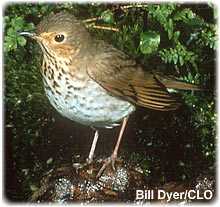
However, this is not the name it was originally given. The first given name, klalilli, in the Chinook language; this was eventually translated, presumably by white settlers, into the name salmonberry (Shaw). In Northwest coast narratives, ripening salmonberries are often referred to as “Swainson’s Thrush” or “Salmonberry Bird” (Kuhlein and Turner). This name appears to derive from the plant’s relationship to the Swainson’s thrush bird species, which arrives each year in May during the ripening time of salmonberries.
The stories from native peoples of the Olympic Peninsula tell of the deep history of human relationships with the salmonberry. In one Makah legend, it is said that if a child stays out past dark, the Basket Woman will come. The Basket Woman will scoop up that child and roast him or her for dinner. In the legend, a young Makah child named Salmonberry stays out on the beach until after dark to see for her/himself if the Basket Lady really exists. Basket Lady appears in the night and takes Salmonberry and her two friends to her hut to be cooked for dinner (Cohlene). The salmonberry’s importance to the tribe is portrayed in the common usage of the name weaved throughout tribal legends and memories.
Although narratives like these are some of the common explanations for how this plant was named, the many uses of the plant also contributed to the name. Traditional uses of the berries, leaves, and roots are thought to be important factors. Historically, native cultures would peel the shoots of the plant and eat them with salmon or salmon eggs (Sims). Others believe that the name simply comes from the fact that the ripened berries have a similar appearance to salmon eggs (EchoHawk).
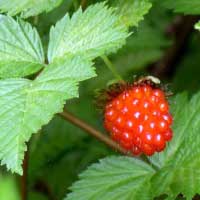
The salmonberry was once a widely used and significant plant to the indigenous people of the Pacific Northwest. Native people gathered the berries, leaves, and roots for a varied range of uses. The berries were eaten plain, or with salmon meat and eggs, occasionally made into jam, and dried. The Makah and Quilette tribes used the leaves and roots dried or in infusions to treat anemia, toothaches, promote weight gain, fix stomach problems, reduce the pains of flesh injuries, and ease labor pains. It some cases, salmonberry was grown for aesthetic value because of its vibrant purple flowers (Fink, Hansen).
The Quileute tribe had a spiritual and ceremonial connection to the salmonberry. On the Quileute calendar, two of its 13 moons are named after the salmonberry, coinciding with the time of year when the shoots and berries began to appear (Fink). They named the seasonal patterns of the annual cycle in terms of the plant and animal resources they relied on for subsistence during those seasons. “Salmonberry sprout days” occurred in April, when the plant would begin to bud with flowers. “Salmonberry days” occurred in June for the beginning of the Salmonberry harvesting season (The Quileute Annual Cycle). Chris Morganroth III of the Quileute tribe describes his tribe’s many uses of the berry in a poem. He talks about eating all portions of the plant, from the berry, to the inside meat of early green sprouts, and steeping the leaves for tea.
“Just some of Mother Nature’s treats, salmonberries ever so sweet.
The crawlies and birds eat them too. They scatter the seeds for me and you
For next season’s sun and rains repeat.
Soft green sprouts in May
Just peel the skins away.
Another morsel not well known
With bright green flesh when not full grown. Then vernalized before the summer ray.
A handful of youthful leaves of green,
When steeped is somewhere in between
The rainbow and the smell of spring.
A surprise the salmonberry’s leaves can bring. There’s a plethora for you to glean”
(Wray 170).
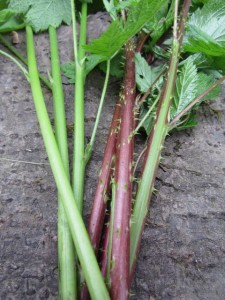
According to Daniel Hart, a professor in the American Indian Studies department at University of Washington, there are different perceptions of cultivated and wild salmonberries. In indigenous culture, there is very little separation between harvesting cultivated and wild salmonberries. They are perceived as the same action for many Native cultures, because the salmonberries are grown as wild, using ecological knowledge of the land to grow and locate the berry for harvesting. In Western society, there is a much more strict separation between cultivated and wild berries. When berries are cultivated a site is selected and prepared, the spacing and design of the space is plotted, and care is taken throughout the plant’s life cycle (i.e. irrigation, fertilization, and weed and pest control) (Barney et. al. 5-22).
The traditional ecological knowledge of the salmonberry represents the belief that humans are a part of nature, and that each one affects the other. With this belief, indigenous practices show a greater care for other plant and animal species. The stories, poems, and spiritual connections to the salmonberry show their respect for and deep knowledge of the plant, and the ecological processes associated with its growth and harvesting.
In today’s Western society, the salmonberry is commonly frozen, canned, or processed into jams and jellies (Kuhlein and Turner). There has been a deterioration of these indigenous cultural practices, which has led to the loss of knowledge surround the cultural and nutritional value of the salmonberry. Genny Rogers, a member of the Skokomish tribe, talks about her relationship to salmonberry, and the differences in the berry’s purpose for her culture and for Western society:
When I was a young girl I visited my grandmother on the reservation in the summer. I only lived ten miles away, but the attitude toward berries was very different in town: they were weeds. On the reservation, salmonberries were treasured not only for the taste, but for the lesson to take the time to stop and pick them off the bush. At that moment eating the delicious berries was the most important task. I learned to take time to enjoy what nature had to offer in the natural setting. No plastic wrapping or cardboard box. It is a lesson that has given me many precious memories of berry picking excursions with my children. (Wray 170)
When settlers first came to the Pacific Northwest they were heavily involved in trading with the local native communities. Because the salmonberry was, and still is, plentiful in the area, many natives would trade the berries and parts of the plant for other supplies. Since the settlers and natives did not have a common language, original names given to goods would often get misinterpreted.
For example, the Chinook word for “food” or “meal” was makamaka (Shaw). While trading the salmonberries, the Chinook would refer to them as makamaka to try to convey to the settlers that the berries were food and could be eaten. The settlers eventually began to exclusively call the salmonberry makamaka because it was so abundant and frequently used in trade. Overtime, the word makamaka transformed into “muckamuck” and became the word used specifically for the salmonberry by the settlers (Shaw).
The salmonberry was scientifically “discovered” by Federick Traugott Pursh, who gave it its technical name, Rubus Spectabilis (Only Foods). The source of this name can be found by looking at the taxonomy of the plant, which begins with the Plantae Kingdom. Plantae are generally known as land plants and green plants, and is a multicellular group. Next in line is the Order, which is Rosales, and includes flowering plants in particular. The salmonberry is then categorized by its Family, Rosaceae, and its Genus, Rubus. The Rosaceae Family is more commonly known as the Rose Family and includes the Rubus Genus, which is comprised of medium to large-sized flowering plants exclusively. Eventually, the salmonberry is classified into its most specific term, Rubus Spectabilis. Spectabilis refers to the flashy dark pink flowers that appear when the salmonberry is in bloom (PNW Plants). In addition to its detailed taxonomy, the plant is also part of the Angiosperm and Eudicot groups. Angiosperms and Eudicots are the most diverse groups of land vegetation and are known for their flowering ground plants (PNW Plants).
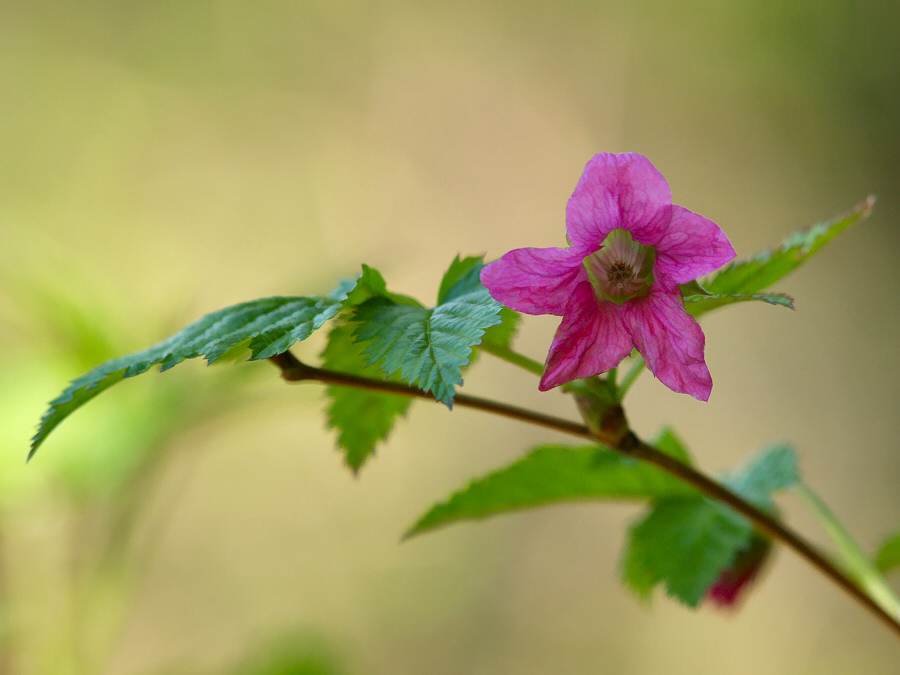
In current day, the salmonberry is viewed more as something that falls between “weed” and intentional. The berries are still eaten and made into wine and jams, but most people seem to prefer sweeter commercial berries not only because their taste is more appealing than that of the sour, watery salmonberry, but also because salmonberries are highly perishable and have a short shelf life. Cooking and preparing the salmonberry can be challenging if a person doesn’t know what they are doing, but the results can be quite tasty and rewarding (see below for a recipe for salmonberries stuffed with cognac and mascarpone cheese provided by a blogger who specializes in cooking with the salmonberry) (Fink).
But because we now use the salmonberry for fewer purposes, we have begun to lose sight of both important traditional ecological knowledge (TEK) and the more subtle benefits the salmonberry provides to the ecosystems in which it grows.
The salmonberry is a significant riparian species, which means that it is a plant whose root system helps to prevent soil erosion. As the salmonberry is removed, soil wears away and washes downstream, especially on the banks of rivers and lakes. Not only does the removal of salmonberry result in soil loss, but it also allows invasive, non-native species, such as scotch broom and purple loosestrife, to take over areas, destroying an ecosystem’s biodiversity (Hansen).
The salmonberry is also a plant that thrives after land is damaged by fire and human driven development. By removing the salmonberry from an ecosystem, we make it that much harder for damaged lands to recover (Hansen).
In addition, the salmonberry fruits and leaves provide food for many animal species. By removing it from an ecosystem we are harming these animals. The best example of this is the hummingbird. All species of the hummingbird that are native to the Pacific Northwest are either listed as vulnerable or endangered species due to habitat and food loss. By removing the salmonberry, we are only harming the hummingbird further (Defenders).
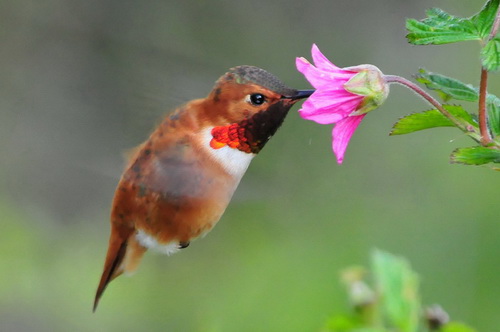
Many of these negative side effects could be reduced if native populations were allowed to freely interact with their environment as they traditionally have. However, barriers restrict Northwest tribes’ access to salmonberries and other harvesting plants. Regulations and laws have been put in place to “protect” native species, but effectively harm native communities’ coeval relationships with these plants. Some regulations require that Indian people obtain permits for harvesting forest products. This requires Indian tribes to spend money and time to apply for these permits in order to use the resources on what were once their native lands.
In a study of the perspective from community members of the Northwest Indian College, community participants said that they no longer have the time to harvest traditional foods. People have families and jobs and must work hard to be financially stable in the Western society, and therefore have no free time to hunt and gather traditional foods. Thus, their diets have changed because these native plants and fish are expensive to buy (Krohn 2010).
Luckily for us, the salmonberry is not an endangered species. Part of this is due to the fact that it can survive in almost any environment. Credit can also be due to the various non-profit environmental groups that are dedicated to aid in the preservation of Native plants such as the salmonberry. It is important to protect our native plants because they hold economic and ecologic values such as the ones mentioned above. Endangered species located within in the United States are protected under what is called the “Endangered Species Act”.
In Washington State however, native plants do not receive protection by law unless they are located on federal lands. When it comes to plants that are located outside federal lands, Washington State has developed non-profit organizations, which, in an attempt to help protect plants in Washington State, give each plant a state status. These plants are classified as threatened, sensitive, endangered, or healthy (“WA Native Plant Society”).
Salmonberry is undervalued in our society due to the fact that its close cousin happens to be the raspberry. However, the Washington State Legislature has methods for the conservation of plants should the salmonberry ever come in danger of extinction.
In 1972, the Washington State Legislature recognized that our natural heritage could be affected by human activities and such plants should be protected. Our legislature has also recognized that there are many benefits to retaining unaltered ecosystems of plants and animals. These benefits include, having places for scientific research and education, while also providing a natural habitat for rare and vanishing species. The Natural Area Preserves Act in 1972 developed a statewide system of over 5 million natural acres that are managed by the Washington Department of Natural Resources.
In terms of individual plant care, the Washington Rare Plant Care and Conservation Organization is dedicated to conserving our States native rare plants through a variety of methods. These methods include both onsite and offsite conservation such as rare plant monitoring, seed collection and storage, plant propagation, and reintroduction of plants into their native habitats. The Washington Rare Plant Care and Conservation works with numerous Federal, state and country agencies including the Washington Natural Heritage Program, US Forest Service, Washington State Parks and the King County Noxious Weed Control Program. They also work with local smaller conservation organizations such as the Woodland Park Zoo in Seattle.
As stated above, the salmonberry positively affects the habitat it is in. In ecosystems where the salmonberry is not present, the Nature Conservancy Organization works to preserve natural habitats around Washington State. The Conservancy monitors plant communities and rare species in protected areas. They also help restore ecosystems that are less healthy than they should be. The Conservancy has protected nearly 400,000 acres in Washington and owns more than 43,000 acres across the state. They work with public and private partners to determine which place is best for natural heritage.
The majority of these organizations are based on a large volunteer population. Because human beings are not the only threats that plants face, The Washington State Department of Agriculture works to protect Washington’s native plants and ecosystems from invasive species such as other plants and animals. They do this through the work of Pest and Nursery Programs. The pest program works with the federal and state partners to detect and eradicate invasive insects, plant disease, and noxious weed invaders such as citrus Long-horned Beetle and Gypsy Moth (WA Native Plant Society).
The salmonberry is a common plant in the Pacific Northwest, but many modern communities know little about it. The multi-purposes of this important plant have been forgotten. Therefore, our goal was to highlight its history, traditional knowledge and uses, modern views of the plant, and the political importance of preserving it. While researching the salmonberry, we first located the plant at the Arboretum and throughout UW campus. We also conducted interviews and thorough Internet research in order to investigate the plant’s qualities. In this blog, we revealed the unique qualities of this plant that make it significant to the Pacific Northwest.
Interested in knowing more about how to identify this plant and use it in your home? See below to find out how!
How to tell if it’s a salmonberry bush.
Modern Recipe:
Salmonberries stuffed with cognac and mascarpone cheese (provided by Saudade blog):
Ingredients:
12 salmonberries, large and varied in color (if desired)
2 Tbsp. Mascarpone cheese
2 tsp. cognac
1 tsp. sugar
4 tsp. honey
4 tsp. water
¼ cup fresh elderflowers
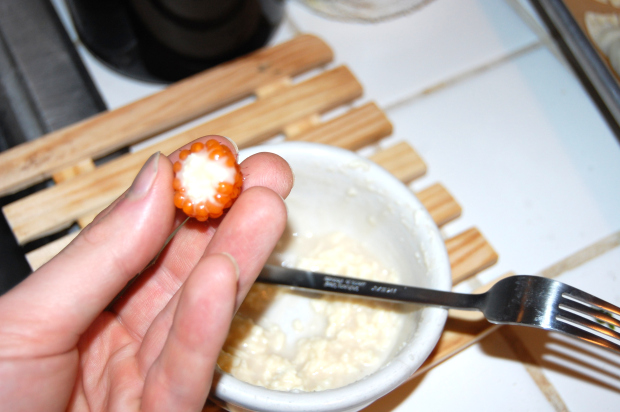
Preparation:
1. Whisk together the mascarpone, cognac, and sugar in a small bowl
2. Pit the salmonberries carefully by removing the inner seed to create a hollow berry (choose berries that are dry, firm, and can take a good amount of handling)
3. With the end of a fork or a chopstick, carefully stuff the salmonberries with the mascarpone mixture
4. Set the berries on a plate and chill in the fridge
5. In a small pot, mix the honey, water, and elderflowers
6. Bring to a boil then reduce the heat to allow mixture to simmer for about 5 minutes
7. Remove from the heat and let sit for 10 minute
8. Strain out the flowers and let syrup cool to just about lukewarm
9. To serve: remove berries from fridge, plate topside up and drizzle with honey-elderflower honey
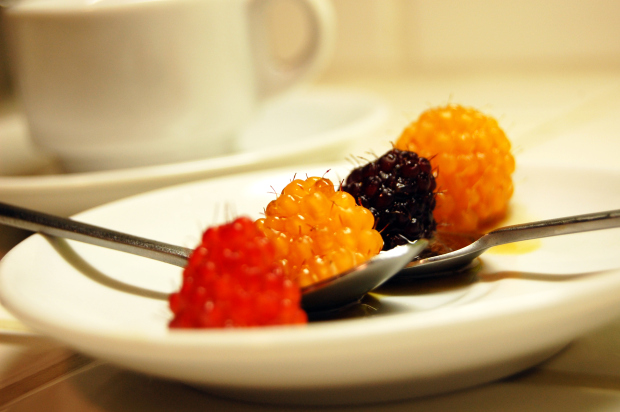
Works Cited
Barney D.L., Colt M., Robbins, J., Wiese M. Growing Raspberries and Blackberries in the Inland Northwest and Intermountain West. University of Idaho, 1999.
Cohlene, T. “Clamshell Boy A Makah Legend”. Native American Legends and Lore. Mahwah, NJ: Troll Communications, 1950.
Cornell Lab of Ornithology. “Swainson’s Thrush (Catharuc ustulatus).” Birds in Forested Landscapes. Web. 18 Nov. 2012. http://www.birds.cornell.edu/bfl/speciesaccts/swathr.html.
Defenders of Wildlife. “Fact Sheet: Hummingbird” N.p. 2012. Web. 14 Nov. 2012. http://www.defenders.org/hummingbirds/basic-facts.
EchoHawk, Terry C. “Traditional Medicine and Foods–Salmonberry and Thimbleberry.” Raven’s Ruff Stuff And Other Things Native. N.p., 2 Apr. 2008. Web. 3 Nov. 2012. http://arcticrose.wordpress.com/2008/04/02/040208-traditional-medicine-and-foods-salmonberry-and-thimbleberry/.
Fink, B. “Salmonberries & Pacific Northwest Cuisine: An Essay.” WordPress. Revised 11 June 2012. Web. 3 Nov. 2012. http://brianfink.wordpress.com/2012/06/08/salmonberries-pacific-northwest-cuisine-an-essay/.
Fink, B. “Salmonberries Stuffed with Cognac and Mascarpone” WordPress. Revised 11 June 2012. Web. 3 Nov. 2012. http://brianfink.wordpress.com/2012/06/11/salmonberries-stuffed-with-cognac-mascarpone/.
Hansen, W. “Salmonberry” The Wild Garden: Hansen’s Northwest Native Plant Guide. N.p. 2012. Web. 14 Nov. 2012 http://www.nwplants.com/business/catalog/rub_spe.html.
Krohn, E. “The Traditional Foods of Puget Sound Project. Northwest Indian College Cooperative Extension Office.” 2010. Pdf.
Krohn, E. “It’s Berry Season.” Wild Foods and Medicines. 2012. Web. 18 Nov 2012. http://wildfoodsandmedicines.com/539/.
Kuhlein H., Turner N. Traditional Plant Foods of Canadian Indigenous People: nutrition, botany, and use. Food and Nutrition in History and Anthropology. Volume 8. Gordon and Breach Science Publishers, Philadelphia, Pennsylvania, USA, 1991.
McMaster, David. “Salmonberry Blossom.” Wikipedia. N.p., 24 Apr. 2005. Web. 14 Nov. 2012. http://en.wikipedia.org/wiki/File:Salmonberry_Blossom.jpg.
Rabourn, Greg. “Salmonberry.” Native Plant Guide. N.p., 2008. Web. 14 Nov. 2012. http://green.kingcounty.gov/gonative/Plant.aspx?Act=view.
“Salmonberry.” PNW Plants. N.p., n.d. Web. 30 Oct. 2012. http://pnwplants.wsu.edu/PlantDisplay.aspx?PlantID=280.
“Salmonberry (Rubus Spectabilis).” Only Foods. N.p., n.d. Web. 30 Oct. 2012. http://www.onlyfoods.net/salmonberry-rubus-spectabilis.html.
Shaw, George C. “Full Text of “The Chinook Jargon and How to Use It : A Complete and Exhaustive Lexicon of the Oldest Trade Language of the American Continent” Internet Archive. N.p., 1909. Web. 3 Nov. 2012 http://archive.org/stream/chinookjargonhow00shawuoft/chinookjargonhow00shawuoftdjvu.txt.
Sims, Vicki. “Salmonberry – A Pacific Northwest Native Shrub.” Home & Garden. N.p., 2011. Web. 1 Nov. 2012. http://www.squidoo.com/salmonberries.
Sitkum and South Fork Calawah Watershed Analysis. The Quileute Annual Cycle. Web. 11 Nov. 2012 http://wcssp.org/WCSSP_library/NF%20Calawah%20WSA/Quileute%20Ann%0Cycle%20NFC.pdf.
United Montessori. “Salmonberry Bush? How Can You Tell?” YouTube. YouTube, 02 June 2009. Web. 14 Nov. 2012. http://www.youtube.com/watch?v=3fH_6mRJN9U.
Wray, J., & Olympic Peninsula Intertribal Cultural Advisory Committee. Native peoples of the Olympic Peninsula: Who we are. Norman: University of Oklahoma Press, 2002. Pg. 170.
Washington Native Plant Society. “Washington Native Plant Society: Conservation,” 26 Oct. 2011. Web. 1 Nov. 2012. http://www.wnps.org/conservation/rare_plants.htm.
________________________________________
About Devon G. Peña
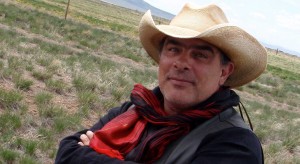 A lifelong activist in the environmental justice and resilient agriculture movements, Devon G. Peña is a Professor of American Ethnic Studies, Anthropology, and Environmental Studies at the University of Washington in Seattle. He also works on the family’s historic acequia farm in San Acacio, Colorado.
A lifelong activist in the environmental justice and resilient agriculture movements, Devon G. Peña is a Professor of American Ethnic Studies, Anthropology, and Environmental Studies at the University of Washington in Seattle. He also works on the family’s historic acequia farm in San Acacio, Colorado.
A pioneering interdisciplinary research scholar and widely-cited author, his most recent books include Mexican Americans and the Environment: Tierra y Vida (U. of Arizona Press, 2005) and The Oxford Encyclopedia of Latinos and Latinas in the United States (senior editor, Oxford University Press, 2005).
Dr. Peña is the Founder and President of The Acequia Institute, the nation’s first Latina/o charitable foundation dedicated to supporting research and education for the environmental and food justice movements.
Read this article as it was originally published here.

Dear Dr. Pena,
My family and I live in Squamish, BC, and the past two nights after dinner we went salmon berry picking (now processing into jam we can enjoy in the dead of winter).
As an anthropologist and someone who will be teaching at the local university this coming fall with the goal of exposing students to the incredible environment around us, I kept coming back to the question of how these amazing berries, bushes, birds, and ecosystem were/are understood by native communities. This is how I found this blog and am impressed by it and appreciative of it! Thank you very much for this project and all that you do at UW.
One last note: I am inspired to write an essay about our berry picking experience (there is one twist I have not mentioned that I think is noteworthy and critical about this excursion) and would like to quote and cite your article, as well as tap into the great bibliography. Don’t know if this essay will just be for personal satisfaction in capturing this personally meaningful event or if it might travel wider (ie. my blog, or further online/print publication), but I will make sure to give credit and appreciation where it is due.
Thanks and wishing you continued success and satisfaction with your work,
Tamar